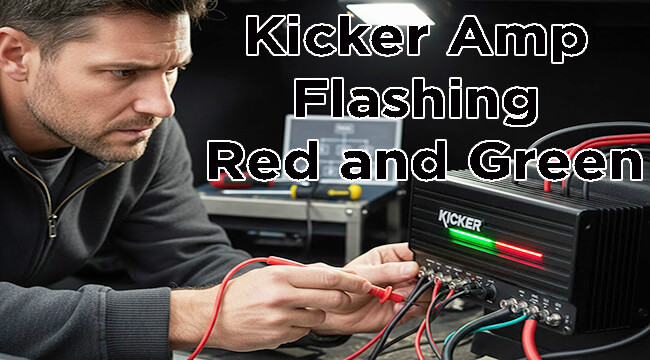Kicker Amp Flashing Red and Green: 4 Steps to Fixed
Your car audio system suddenly goes silent. You check your Kicker amplifier for answers. A strange light pattern blinks back at you. Red and green lights are flashing together. This is a very frustrating and specific problem. It signals something different than a simple error. Many users face this confusing light show.

I have worked on car audio for years. I see this exact issue quite often. It points to an internal amplifier fault. But do not worry about this issue. I will guide you through the solution.
# Table of Contents =>
- 1 Step-by-Step Guide to Kicker Amp Flashing Red and Green Fixes:
- 1.1 Step 1: Isolate the Amplifier Completely
- 1.2 Step 2: Check Your External Connections
- 1.3 Step 3: Verify Power, Ground, and Remote
- 1.4 Step 4: Perform a Bench Test
- 1.5 What to Do About an Internal Fault –
- 1.6 A Note on DIY Amplifier Repair –
- 1.7 How to Prevent Future Amplifier Problems –
- 1.8 My First Experience with This Exact Issue –
- 1.9 Disconnect the Main Power Fuse –
- 1.10 Let the Amplifier Cool Down Completely –
- 1.11 Internal Power Supply Unit (PSU) Failure –
- 1.12 Failed Output Transistors (MOSFETs) –
- 1.13 A Short Circuit on the Circuit Board –
- 1.14 Final Thoughts on Your Kicker Amplifier:
The Flashing Red and Green Lights –
Most Kicker amps use simple diagnostic lights. A solid green light means normal operation. A solid red light means protection mode. Protection mode activates for several reasons. Low voltage can cause a red light. A speaker short can also cause it. Overheating is another common protection trigger.
However, flashing red and green is different. This is not the standard protection mode. Kicker designs this code for specific faults. It almost always means an internal failure. The power supply section might be bad. The output transistors could have failed. Do not assume it is a simple fix. We must investigate this problem carefully.
Step-by-Step Guide to Kicker Amp Flashing Red and Green Fixes:
Now we will start the hands-on diagnosis. We need one tool for these tests. A simple digital multimeter is essential. You can get one at any hardware store. It helps us check voltages and continuity. Follow these steps in the correct order. This helps us isolate the real problem.
Step 1: Isolate the Amplifier Completely
We must confirm the amp is the problem. External wiring can sometimes cause issues. We will remove all external connections. This creates a controlled testing environment.
- Disconnect the RCA signal cables.
- Unscrew all of the speaker wires.
- Remove the remote turn-on wire.
- Leave only power and ground connected.
Now, put the main fuse back in. Does the amp power on normally (green light)? If so, the problem is external. If it still flashes red and green, it’s internal. This is a very crucial first step.
Step 2: Check Your External Connections
If the amp worked in the last step, great. The problem is with your wiring. We will now check each connection.
a) Inspect RCA Cables
RCA cables can sometimes have internal shorts. A frayed wire can cause a ground fault. Try a different set of RCA cables. See if the problem goes away. This is a quick and easy test.
b) Examine Speaker Wires
Look closely at your speaker wires. Check for any breaks or frayed strands. A single strand can cause a major short. Ensure no strands are touching the chassis. Also check the speaker box terminals.
c) Test Your Speakers
A blown speaker can have a shorted coil. Use your multimeter to check the impedance. Set it to the ohms setting (Ω). A 4-ohm speaker should read around 3-4 ohms. A reading of zero means a short. Replace any shorted or bad speaker.
Step 3: Verify Power, Ground, and Remote
If the amp flashes with nothing connected, check power. The amp needs stable voltage to work. We will use our multimeter for this.
a) Test Main Power and Ground
Set your multimeter to DC Volts. Place the red probe on the amp’s +12V terminal. Place the black probe on the ground terminal. You should see over 12.0 volts. Start the car to get a better reading. It should be between 12.5 and 14.4 volts. A lower voltage indicates a power issue.
b) Check the Ground Connection
A bad ground is the most common issue. It causes countless amplifier problems. Your ground wire must be securely attached. It should connect to bare chassis metal. Remove the screw and sand the paint. A clean metal-to-metal contact is vital. I always double check the ground connection.
c) Verify the Remote Turn-On Wire
The remote wire acts like a switch. It tells the amplifier when to turn on. It should have +12V when the radio is on. Check this with your multimeter. Place the black probe on the ground terminal. Place the red probe on the remote terminal. You should see +12V with the stereo on.
Step 4: Perform a Bench Test
A bench test is the final confirmation. It removes the car’s wiring from the equation. This will tell us with 100% certainty. The problem is either the amp or not.
a) Remove the Amplifier from the Car
Carefully remove the mounting screws. Take the amplifier out of your vehicle. Place it on a non-conductive surface. A wooden workbench or cardboard is perfect. This prevents any accidental short circuits.
b) Connect to a Separate Battery
Use a known good 12V car battery. Use short lengths of thick gauge wire. Connect the battery positive to the amp’s +12V. Connect the battery negative to the amp’s ground. Use a small jumper wire for the remote. Connect it from the +12V terminal to the remote terminal.
c) Analyze the Result of the Test
If the amp still flashes red and green? The amplifier is internally faulty. There is no doubt about it now. If the amp powers on with green light? The problem lies in your car’s wiring. This test ends all of the guesswork.
What to Do About an Internal Fault –
Our tests have confirmed an internal fault. The amp itself is definitely broken. Now you have a few important choices. You need to decide on your next step.
Option 1: Professional Repair Service
You can send the amp for repair. Find a qualified car audio repair shop. They have the tools and the experience. They can diagnose the specific failed component. The repair cost can vary greatly. A simple fix might be inexpensive. A major failure could be more costly. Get a price estimate before you agree. Sometimes the repair cost is too high.
Option 2: Contact Kicker Support
If your amplifier is still under warranty, contact Kicker. They have an excellent customer service team. They will guide you through their warranty process. You may get a repaired or new unit. Even if it is out of warranty, ask. They may offer a flat-rate repair service. This can sometimes be very affordable. It is always worth checking with them.
Option 3: Replace the Amplifier
Sometimes, replacement is the best choice. Consider the age of your current amplifier. Amplifier technology improves over the years. A new amplifier might be more efficient. It could have better features for you. Compare the cost of repair to a new amp. A new unit also comes with a fresh warranty. This provides you with peace of mind.
A Note on DIY Amplifier Repair –
I do not recommend DIY internal repairs. Unless you are an electronics technician. Amplifier circuits are very complex. They operate with high internal voltages. You can easily cause more damage. You can also receive a dangerous electric shock. It is much safer for most people. Let a trained professional handle internal repairs.
How to Prevent Future Amplifier Problems –
Prevention is always better than a cure. Proper installation is key to long life. Following best practices protects your investment.
a) Ensure Proper Airflow and Cooling:
Amplifiers generate a lot of heat. Heat is the number one enemy of electronics. Mount your amp where air can circulate. Do not cover it with carpets or luggage. Use small spacers to lift it slightly. This allows air to flow underneath it. An overheated amp will fail much sooner.
b) Use the Correct Wire Gauge:
Use the proper gauge power and ground wire. Kicker provides recommendations in the manual. Thicker wire delivers current more efficiently. Undersized wire restricts current and creates heat. This can starve the amplifier of power. It will lead to poor performance and failure.
c) Set Your Gains Correctly:
The gain knob is not a volume control. It matches the head unit’s output voltage. Setting the gain too high causes clipping. A clipped signal is a distorted square wave. This sends dangerous DC voltage to speakers. It also severely overheats the amplifier. Learn to set gains using a multimeter. This will save your amp and your speakers.
My First Experience with This Exact Issue –
I remember my first encounter with this. A client brought in his Kicker CX amp. It was flashing both red and green. He had already checked all his wiring. The power and ground wires were perfect. His speaker connections were also very solid. He spent hours looking for a solution. I took the amplifier to my workbench. So, disconnected everything from the car.
I gave it clean power on my bench. The same red and green lights appeared. This test confirmed the problem was internal. It was a failure in the power supply. This experience taught me a valuable lesson. This light code is serious and specific.
Initial Safety Steps You Must Take Now:
Before we touch anything, safety comes first. Car batteries hold a lot of energy. A mistake can damage your equipment. It can also cause you serious injury. We must follow some basic safety rules. This protects you and your audio system.
Disconnect the Main Power Fuse –
Find the main fuse for your amplifier. This fuse is near your car’s battery. It is in a large fuse holder. Pull this fuse out of the holder. This completely cuts power to the amp. Now the main power wire is safe. You can work without fear of sparks. This is the most important safety step. Never skip this initial safety procedure.
Let the Amplifier Cool Down Completely –
Amplifiers can get very hot during use. If you were just playing music loud, wait. Let the amplifier cool for thirty minutes. Touching a hot amp can burn you. Also, heat can affect diagnostic tests. A cool amplifier gives more accurate readings. So please be patient for a little while. Your safety is our top priority here.
Why Your Kicker Amp Is Flashing Red and Green:
Understanding the cause helps find the solution. This specific error code is not common. It points away from typical user errors. It suggests a deeper hardware level problem. Let’s look at the most likely reasons. I have seen these causes in my shop.
Internal Power Supply Unit (PSU) Failure –
The amplifier has its own power supply. It converts 12-volt DC to higher voltages. This internal PSU powers the sound circuits. The components in the PSU can fail. Capacitors can leak over a long time. MOSFETs in the PSU can short out.
A PSU failure stops the amp completely. The diagnostic circuit sees this major fault. It then flashes the red and green lights. This is a very common internal failure.
Failed Output Transistors (MOSFETs) –
Output transistors create the powerful audio signal. They drive your subwoofers or speakers. These components handle significant power and heat. They can fail due to many reasons. Constant overheating can weaken these parts.
Running a very low impedance load can help. Sending a clipped, distorted signal can kill them. When an output transistor fails, it shorts. The amp’s brain detects this short circuit. It triggers the red and green flash.
A Short Circuit on the Circuit Board –
Sometimes the problem is more unusual. A small piece of metal can fall inside. It might land on the circuit board. This can short two important points together. A loose screw can also cause this. Even a stray strand of speaker wire. This creates a direct short inside. The amplifier cannot operate under these conditions. The lights tell you something is wrong inside. This is less common but still possible.
Final Thoughts on Your Kicker Amplifier:
Seeing a Kicker amp flashing red and green is alarming. It is not a standard protection mode warning. It signals a serious internal hardware fault. By following our guide, you can be sure. You isolated the amp from all variables. You confirmed the problem is not external.
Now you know the truth about it. You can now make an informed decision. You can choose repair, warranty, or replacement. Proper installation will prevent future problems. Your music will be back on soon.
Last Updated on October 7, 2025 by Perry Garner


